Short Gun Sturmgeschütz
III kits in 1/72 |
www.onthewaymodels.com |
by Stephen 'Tank Whisperer' Brezinski | |||
Short Gun Sturmgeschütz
III kits in 1/72 |
www.onthewaymodels.com |
by Stephen 'Tank Whisperer' Brezinski | |||
| sbrez1(at)comcast(dot)net Edited by Marc Mercier |
| With
the Dragon StuG III C/D kit no. 7553, we see a pair of well drawn
Sturmgeschuetz. The vehicles are painted in panzer gray and with white
crosses. On the pannier we see a red unit marking and a vehicle name
'Prince Eugen'. This model and StuG variant is referred to as the
Ausf. C/D as there was no noticeable external difference between the
StuG Ausf. C and Ausf. D.
We see a lot of similarities with the similar Ausf A and B, such as the headlights, the panniers and driver's visor. What is different is the antenna trough, the new style sprocket wheel for wider track, and the opening for the direct gunsight is now gone. Protruding from the roof we see the periscope gun sight sticking up. Considering
the simplicity of this model compared to Dragon 1/72 kits of a few
years ago, I think they should remove the term "ARMOR PRO"
from the box. |
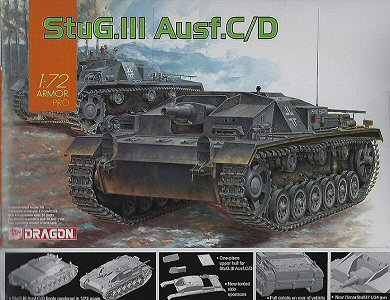 |
| The
box art for Trumpeter Models StuG III Ausf. C/D, kit no. 7257 again
shows a photo of the actual model. The vehicle looks like a reasonably
accurate StuG III C/D. Like with the Dragon box art we see the deletion
of the direct fire opening for the gunsight on the port side. Notice
that on the starboard side here there is no rectangular box in the
pannier. On the side of this sloped pannier we see a long rib that
represents a grab handle and may be best replaced with a new handle
from wire. The bow tow points can be drilled and pins inserted.
Several historical photos show spare track links mounted on the nose when completed at the factory. The sprockets in this photo have hubcaps covering the bolts while Trumpeter's StuG III E kit box art shows sprockets with no hubcaps. This
is the only short gun StuG variant that served in North Africa,
three Ausf. D were sent in July 1941. Another StuG III Ausf. D was
photographed at the end of the war upgraded with a long 75-mm StuK
40 gun and cast Topfblende gun mantlet (for more information on
this vehicle see here). |
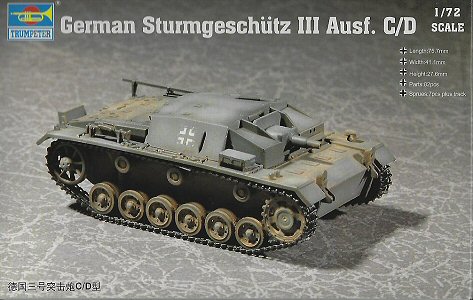 |
| The Kit Instructions | |
| Dragon
StuG III C/D kit 7553 first few pages show assembly of the
sprocket and idler wheels, and the middle steps of the hull. Between
Step-1 and Step-2 we see the instruction to cut excess plastic off
the one-piece slide-molded hull to change it from a late StuG hull
to an early StuG hull. We must do this for the Dragon StuG III Ausf.
A, Ausf. B and Ausf. E kits. At upper left is assembly of the 7.5-cm
L24 gun (parts A37 and A38) which is similar to the gun parts in the
Trumpeter model. Both the Dragon and the Trumpeter L24 guns have open
muzzles thanks to slide molding.
Here in Step-2 we see one of the weak points of these recent Dragon short gun StuG models: the rear idler Parts (A7 & A8) are molded as on thick wheel, rather than as two separate wheels. For a display model I find this unacceptable. We should at least take a saw or a file and open up a groove around the wheel to simulate two separate wheels. A nice touch are the separate shock absorbers (parts A19 thru A22). At upper right is a small decal sheet with names
for two German vehicles PRINZ EUGEN, and SEYDLITZ. I miss it when
Dragon gave us a huge decal sheet with a half dozen vehicles. |
 |
| In
this page of the instructions for Trumpeter Models StuG III
Ausf. C/D we have the parts diagram and assembly of the wheels.
Over on Sprue-C we see a spot where Trumpeter used to include an extra
superstructure. The section is essentially the same as this of the
Trumpeter StuG Ausf. B and Ausf. E kits. The
small water slide decal sheet at upper right is the same as for
their StuG III Ausf. C/D kit. According to this decal sheet, it
is used for Trumpeter kits 7256, 7257 and 7258. The decal sheet
looks in-register. I am unsure at this time why the cross next to
the name Leopard is on a background of gray. At time of production
this vehicle would have been panzer gray in color anyway. I need
to find a good reference photo of this particular vehicle. One model
of this vehicle shows it in winter whitewash with the name on a
gray background exposed, but I've not yet found an actual photo
of this particular Sturmgeschütz. |
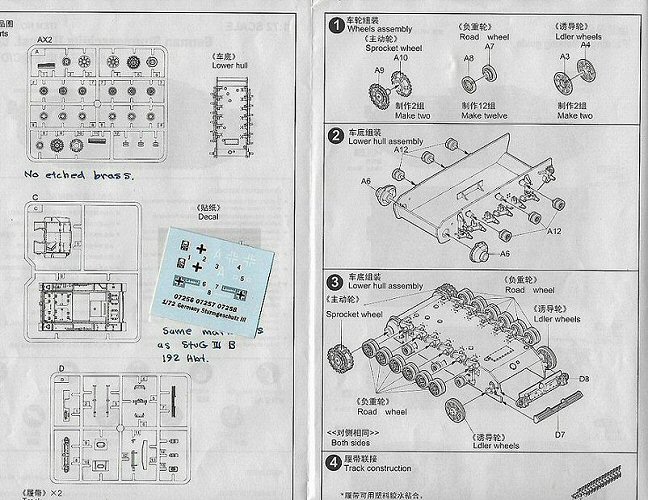 |
The Kit Parts The Trumpeter Models StuG III Ausf. C/D model comes with 69 pale-gray injection molded plastic parts, and two soft plastic band tracks. Quality is good with crisp consistent molding. In the Dragon StuG III Ausf. C/D kit I counted 29 pale gray, injection molded styrene plastic parts, and two black softer plastic track assemblies. These are the same one-piece track/wheel units discussed in the preview of the Dragon StuG III Ausf. A and StuG Ausf. F; with all its issues. There are six extra, unused parts including two extra gun barrels. Quality is good with crisp consistent molding. Many of the parts for these two StuG III Ausf. C/D models are discussed in Parts 1 and 3 of my review. To avoid repetition I refer you to the other reviews for additional information. Here
we have the Dragon StuG III Ausf. C/D upper hull at left in comparison
with the Trumpeter upper hull at right. My Trumpeter hull has a
light coat of gray paint which explains the mottled appearance.
Both kits appear well molded and with most of the tools molded to
the fenders. Both kits have closed crew hatches (disappointing).
|
|
|
On the Trumpeter superstructure roof we see the big triangular hole for the periscope gun sight. Recall on the StuG III A and B kits there was a small roof hatch for this gunsight. There is no periscope gunsight included, but that can be scratchbuilt with some plastic rod. This hole in the roof appears to have no doors that I have ever seen in photos, just open to the environment. On some StuG I have seen this hole covered with a wire screen, I suppose to keep out hand grenades. You will notice that the Dragon StuG roof has no opening for the periscope gunsight at all. There is a shallow depression and a little nub representing the periscope gunsight. Okay for a wargaming kit, but not at all acceptable for a good display model. One option is to cover the front area with a simulated tarp; tarps have been seen keeping weather from coming in around the superstructure's gun opening. A little digression, you may have heard or read
about how the Ferdinand heavy tank destroyer was so unsuccessful
at the Kursk battle because it had no machine gun to protect itself
from Soviet infantry. Keep in mind that most of the Sturmgeschütz,
the ISU-152, SU-85 and the SU-100 also did not have hull machine
guns but were considered very successful vehicles. |
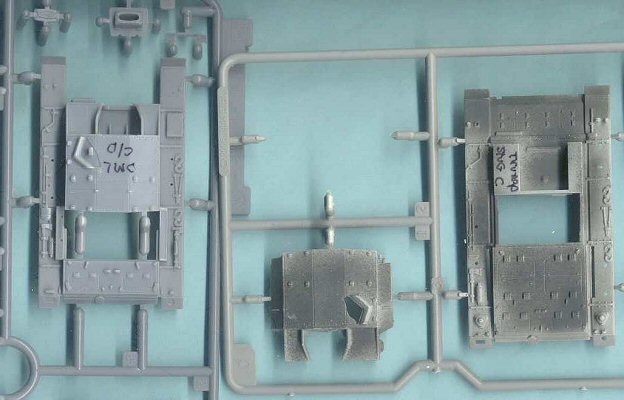 |
| At
left in this scan is part of one of Trumpeter's two Sprue A holding
the wheels and air intakes (Parts-A1 and A11). Both the sprocket (parts
A9 and A10) and the idler wheel (parts A3 and A4) are both molded
in two parts, left and right sides. At lower left are the slide-molded
return rollers (parts A12). This sprue is also within the Trumpeter
StuG III Ausf. E and Ausf. F, and Ausf. G kits
At right in slightly darker gray plastic is part of Dragon's sprue-A. These parts are common with Dragon's StuG III Ausf. E and Ausf. F kits. Unlike the Trumpeter idler wheel, Dragon has regressed to a one-piece idler wheel and deleted the track teeth around the idler and sprocket wheels. We also have some unused parts for a long 75-mm L48 gun, and parts A2 and A25. There are no return rollers on this Dragon sprue as they are cast into the one-piece track run. At far right we have four individual shock absorbers
(parts 19 thru A22). So Dragon gives us separate shock absorbers
but cuts corners with the idler wheels? Giving credit where it is
due, the Dragon parts are cast well with no problem sink holes or
flash. |
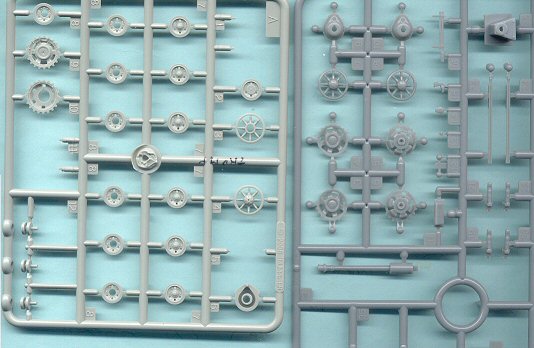 |
References
|
|
|
Back to Articles List |
| Article
Last Updated: 15 May 2018 03 June 2018 |
Back to Home Page |